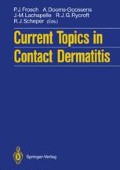Abstract
More than 90% of the used epoxy resins are of the bisphenol-A type [1]. The monomer with a molecular weight of 340 is a strong sensitizer [12]. It is widely used in several branches of industry and may cause major dermatological problems and change of occupation among sensitized workers [11]. Also methyl-methacrylate monomer is a strong sensitizer [4] and appears to be the main cause of skin problems among dental technicians [3, 5]. Among orthopaedic surgeons several cases of sensitization from self-curing acrylate resins have been described [6, 10].
Access this chapter
Tax calculation will be finalised at checkout
Purchases are for personal use only
Preview
Unable to display preview. Download preview PDF.
References
Adams RM (1983) (ed) Occupational skin disease, Grune and Stratton, New York, pp 241–250.
Blanken R, Nater JP, Veenhoff E (1987) Protection against epoxy resins with glove materials. Contact Dermatitis 16: 46–47.
Blichmann CW, Roed-Petersen J (1986) Erhvervsbetingede hudproblemer hos laboratorietandteknikere. Ugeskr Læger 148: 1370–1372.
Chung CW, Giles AL (1977) Sensitization potentials of methyl, ethyl, and n-butyl methacrylates and mutual cross-sensitivity in guinea pigs. J Invest Dermatol 68: 187–190.
Estlander T, Rajaniemi R, Jolanki R (1984) Hand dermatitis in dental technicians. Contact Dermatitis 10: 201–205.
Fisher AA (1973) Acrylic bone cement sensitization and dermatitis. Cutis 12: 333–337.
Henriksen HR, Madsen JØ, Petersen HJS (1987) Bedre prøvningscelle og vurdering af tæthed. Arbejdsmiljæfondets forskningsrapporter. Beskyttelsesklæder mod kemikalier II. Arbejdsmiljøfondet, Copenhagen.
Henriksen HR, Petersen HJS (1986) Bedre handsker mod epoxy og andre kemikalier. Arbejdsmiljøfondets forskningsrapporter. Beskyttelsesklæder med kemikalier, Arbejdsmiljøfondet, Copenhagen.
Pegum JS (1979) Penetration of protective gloves by epoxy resin. Contact Dermatitis5: 281–283.
Pegum JS, Medhurst FA (1971) Contact dermatitis from penetration of rubber gloves by acrylic monomer. Br Med J 2: 141–143.
van Putten PB, Coenraads PJ, Nater JP (1984) Hand dermatoses and contact allergic reactions in construction workers exposed to epoxy resins. Contact Dermatitis 10: 146–150.
Thorgeirsson A, Fregert S (1977) Allergenicity of epoxy resins in the guinea pig. Acta Derm Venereol (Stockh) 57: 253–256.
Author information
Authors and Affiliations
Editor information
Editors and Affiliations
Rights and permissions
Copyright information
© 1989 Springer-Verlag Berlin Heidelberg
About this paper
Cite this paper
Roed-Petersen, J. (1989). A New Glove Material Protective Against Epoxy and Acrylate Monomer. In: Frosch, P., Dooms-Goossens, A., Lachapelle, JM., Rycroft, R.J.G., Scheper, R.J. (eds) Current Topics in Contact Dermatitis. Springer, Berlin, Heidelberg. https://doi.org/10.1007/978-3-642-74299-6_117
Download citation
DOI: https://doi.org/10.1007/978-3-642-74299-6_117
Publisher Name: Springer, Berlin, Heidelberg
Print ISBN: 978-3-642-74301-6
Online ISBN: 978-3-642-74299-6
eBook Packages: Springer Book Archive

